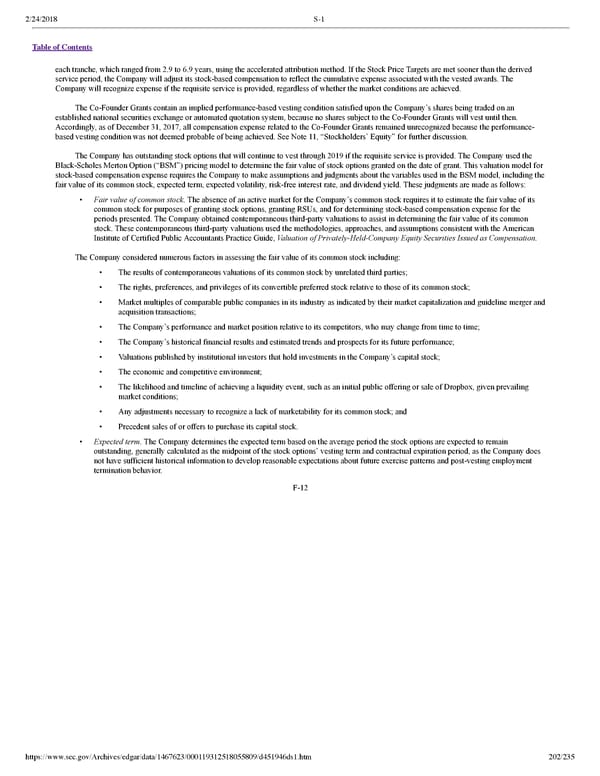2/24/2018 S-1 Table of Contents each tranche, which ranged from 2.9 to 6.9 years, using the accelerated attribution method. If the Stock Price Targets are met sooner than the derived service period, the Company will adjust its stockbased compensation to reflect the cumulative expense associated with the vested awards. The Company will recognize expense if the requisite service is provided, regardless of whether the market conditions are achieved. The CoFounder Grants contain an implied performancebased vesting condition satisfied upon the Company’s shares being traded on an established national securities exchange or automated quotation system, because no shares subject to the CoFounder Grants will vest until then. Accordingly, as of December 31, 2017, all compensation expense related to the CoFounder Grants remained unrecognized because the performance based vesting condition was not deemed probable of being achieved. See Note 11, “Stockholders’ Equity” for further discussion. The Company has outstanding stock options that will continue to vest through 2019 if the requisite service is provided. The Company used the BlackScholes Merton Option (“BSM”) pricing model to determine the fair value of stock options granted on the date of grant. This valuation model for stockbased compensation expense requires the Company to make assumptions and judgments about the variables used in the BSM model, including the fair value of its common stock, expected term, expected volatility, riskfree interest rate, and dividend yield. These judgments are made as follows: • Fair value of common stock. The absence of an active market for the Company’s common stock requires it to estimate the fair value of its common stock for purposes of granting stock options, granting RSUs, and for determining stockbased compensation expense for the periods presented. The Company obtained contemporaneous thirdparty valuations to assist in determining the fair value of its common stock. These contemporaneous thirdparty valuations used the methodologies, approaches, and assumptions consistent with the American Institute of Certified Public Accountants Practice Guide, Valuation of PrivatelyHeldCompany Equity Securities Issued as Compensation. The Company considered numerous factors in assessing the fair value of its common stock including: • The results of contemporaneous valuations of its common stock by unrelated third parties; • The rights, preferences, and privileges of its convertible preferred stock relative to those of its common stock; • Market multiples of comparable public companies in its industry as indicated by their market capitalization and guideline merger and acquisition transactions; • The Company’s performance and market position relative to its competitors, who may change from time to time; • The Company’s historical financial results and estimated trends and prospects for its future performance; • Valuations published by institutional investors that hold investments in the Company’s capital stock; • The economic and competitive environment; • The likelihood and timeline of achieving a liquidity event, such as an initial public offering or sale of Dropbox, given prevailing market conditions; • Any adjustments necessary to recognize a lack of marketability for its common stock; and • Precedent sales of or offers to purchase its capital stock. • Expected term. The Company determines the expected term based on the average period the stock options are expected to remain outstanding, generally calculated as the midpoint of the stock options’ vesting term and contractual expiration period, as the Company does not have sufficient historical information to develop reasonable expectations about future exercise patterns and postvesting employment termination behavior. F12 https://www.sec.gov/Archives/edgar/data/1467623/000119312518055809/d451946ds1.htm 202/235
 Dropbox S-1 | Interactive Prospectus Page 201 Page 203
Dropbox S-1 | Interactive Prospectus Page 201 Page 203